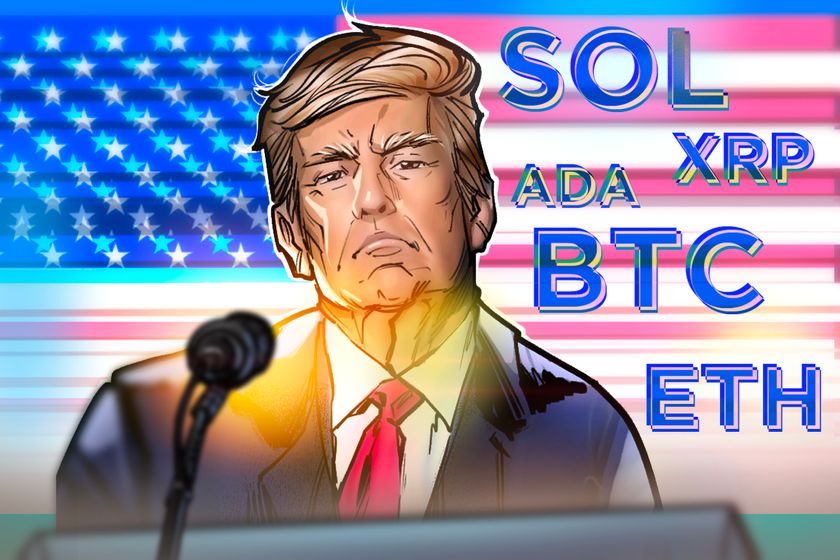The cryptocurrency world is buzzing following a significant announcement from US President Donald Trump regarding the establishment of a US strategic crypto reserve. While many eyes are on the immediate market reactions, particularly the price surges of included coins like Bitcoin (BTC) and Ethereum (ETH), there is a deeper narrative worth exploring. According to Tim Haldorsson, founder of Lunar Strategy, this declaration marks a pivotal moment for the legitimacy of various blockchain platforms, setting the stage for broader innovation and growth opportunities across multiple sectors.
The endorsement of these cryptocurrencies by the government could serve as a catalyst for a burgeoning ecosystem, inviting new projects to build with renewed confidence on established networks like Solana and Cardano.
This government approval significantly alters the risk landscape for developers, clearing a pathway where uncertainty once loomed. Projects based on these newly legitimized platforms, such as those focused on decentralized finance (DeFi), crosschain interoperability, and even gaming, now operate with a newfound assurance that their foundational technologies will remain secure from regulatory threats. The immediate effects are already visible: Cardano’s ecosystem, for example, has experienced a surge in trading volume and interest in DeFi protocols, while Ethereum and Solana are also seeing capital shift toward innovative projects.
As retail and institutional investors recalibrate their strategies, this endorsement strengthens the case for a multichain future, where various blockchains coexist and thrive together rather than compete in a winner-takes-all scenario.
However, not all projects may benefit equally from this development. Haldorsson highlights that while certain sectors may see disproportionate growth in the wake of this announcement, investors should focus on key metrics like total value locked, developer activity, and user adoption to identify promising opportunities. Beyond mere speculation, projects that prioritize robust security measures and proactive regulatory compliance are likely to attract increasing interest from venture capitalists, particularly as funding dynamics evolve in response to these developments.
With a supportive governmental backdrop, interoperability solutions that integrate these networks are poised to become essential as the crypto community embarks on this journey toward widespread blockchain adoption.
As this landscape continues to unfold, the long-term implications of the strategic reserve announcement could reshape the way blockchain technologies are perceived and utilized, potentially laying the groundwork for a new phase of digital infrastructure development reminiscent of the internet’s ascent from a government initiative to a commercial powerhouse.
The Impact of the US Strategic Crypto Reserve Announcement
In the wake of the strategic crypto reserve announcement by US President Donald Trump, several key points emerge that may significantly impact investors, developers, and users within the blockchain ecosystem.
- Government Endorsement
- This legitimizes major cryptocurrencies like Bitcoin, Ether, XRP, Solana, and Cardano, impacting their perceived long-term viability.
- Creates a favorable environment for innovation, leading to potential investment opportunities.
- Confidence in Development
- Developers on Ethereum, Solana, and Cardano gain assurance from reduced regulatory uncertainty.
- Infrastructure projects stand to grow substantially due to increased confidence and support.
- Increased Investment Flow
- Sectors such as DeFi and infrastructure are poised for greater investment from both retail and institutional players, attracted by the government backing.
- Venture capital might shift focus towards projects on endorsed networks, changing the typical funding landscape.
- Emerging Opportunities in Blockchain Sectors
- Crosschain DeFi protocols and digital identity solutions are likely to see renewed interest, benefitting from government-endorsed networks.
- Blockchain gaming may accelerate growth as developers leverage legitimized platforms for credibility in partnerships.
- Key Metrics for Assessing Projects
- Total Value Locked (TVL), developer activity, and user adoption metrics will be critical in differentiating strong projects from speculative ones.
- Compliance and security will become increasingly important as government scrutiny rises.
- Interoperability Will Be Crucial
- As multiple chains are endorsed, the need for crosschain solutions becomes vital for efficient user experience and asset management.
- Projects facilitating seamless movement between networks may see significant growth.
- Long-Term Growth Projections
- Initial price rallies could be the precursor to substantial ecosystem development over the coming years.
- The potential for blockchain to evolve into mainstream digital infrastructure is on the horizon.
This announcement could herald a new phase of widespread blockchain adoption, influencing the way we interact with technology and finance.
The Impact of Government-Endorsed Blockchain on the Crypto Ecosystem
Tim Haldorsson’s opinion piece sheds light on the recent governmental endorsement of major cryptocurrencies and its implications for the crypto ecosystem. This endorsement not only promises immediate price surges for cryptocurrencies like Bitcoin, Ethereum, and Cardano but signals a monumental shift in the risk landscape for blockchain projects. Compared to other recent news in the blockchain realm, Haldorsson’s analysis provides a nuanced perspective on the emerging opportunities and potential pitfalls arising from this newfound legitimacy.
Competitive Advantages: The strategic crypto reserve creates a unique scenario where blockchain projects can operate on a newly validated platform. This endorsement acts as a seal of approval, effectively reducing regulatory uncertainties that often stifle innovation. Projects built on these legitimized networks now enjoy enhanced investor confidence, facilitating access to funding and user adoption. Unlike projects in other unregulated chains that lack legitimacy and face intense scrutiny, those associated with government-supported platforms can leverage this credibility to secure partnerships and traction in the market. The focus on building essential infrastructure also positions these projects favorably within an evolving blockchain landscape, allowing them to capture a larger share of institutional interest.
Additionally, sectors like decentralized finance (DeFi) and gaming are poised for exemplary growth. With government backing, these applications may attract an influx of retail and institutional investors, significantly shifting market paradigms. The analysis illustrates how projects that prioritize compliance and security are likely to rise as investors become increasingly cautious, marking a shift in what types of projects receive funding.
Potential Disadvantages: However, not all projects stand to gain equally from this trend. While DeFi initiatives may surge, other sectors may struggle to find relevance or funding, particularly those perceived as overly speculative. As venture capital increasingly becomes selective, startups that fail to demonstrate solid execution may find it challenging to attract necessary investment. This could lead to a competitive disadvantage for projects that cannot pivot towards compliance and regulatory measures to meet evolving investor expectations. Moreover, with a focus on bridging and interoperability solutions, specialized projects may find themselves overshadowed by the more prominently endorsed networks like Ethereum and Solana, making it difficult to carve out a niche.
Who Benefits and Who Faces Challenges: The primary beneficiaries of this strategic reserve endorsement are likely to be blockchain developers and entrepreneurs building on these legitimized platforms. They will enjoy the security of government validation, warding off existential regulatory fears and fostering innovation. Conversely, projects anchored on less recognized chains may struggle to maintain relevance due to shrinking investment interest and market volatility. Regulations surrounding compliance could pose significant challenges for startups unprepared to align with the new institutional expectations. Vulnerabilities may emerge for companies lacking resource capabilities to meet rising security standards as focus shifts to reliability and stability. As a result, the endorsement casts a dual spotlight on the promise of innovation while also emphasizing the need for robust project foundations.

















